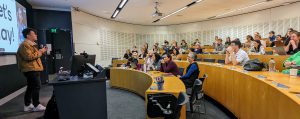Universities spend a lot of time thinking and talking about students. From how we improve teaching on a day-to-day basis, through to how we respond to seismic events such as the Covid-19 pandemic or the ascendency of generative AI. While universities pore over student data, be it assessment, enrollment, or student surveys, directly partnering with students to share in the decision-making process is a lot less widespread. However, as Joseph Callari, an exchange student enrolled in the University of Sydney’s third-year unit WORK3205 Organizational Communication put it:
Everyone has a voice that can be shared. Every decision you’re making, you’re making regardless so why not make students part of it
Joseph Callari, Student Partner

The question, why don’t we involve students in decisions about their learning, is one that educators and students explored together as part of an immersive session at the 2023 Sydney Teaching Symposium. Led by University of Sydney Business School Lecturer Dr Maria Ishkova and her 26 student partners, the session focused on how teachers can partner with students as part of their teaching and learning experience. Though the field of students as partners (SaP) is well established, for many educators, the reality of divesting oneself of control over the micro decision-making that goes into each and every class can be daunting. Overcoming the established norms of the teacher in charge is hard and being the one at the front of the room offers power but also vulnerability. And even if we overcome these fears and invite our students to join us, what next? What practical things can we do, especially within the tight constraints of an already busy semester?

Maria and her students demonstrated in a single immersive session that: 1) there are small practical things that can be done to partner with students and 2) sharing the responsibility for teaching and learning opens up more space for creativity, joy and human connection. In a lesson on how form can follow function, students presented short pitches, speeches and even a poem – each of which explored that a facet of an educational experience made transformational by delivering on its promise of autonomy:
For students to be intrinsically motivated we need some level of autonomy and for that class we had that autonomy. We had some ability to say “you know what I’m really interested in this area and we would love to research it!” […] I feel like the things I’ve learnt in this class are things that I will take with me into the rest of my life. So it has been really beneficial.
Tameea Lock, Student Partner
Now knowing what partnership could be, the session switched over to rapid speed dating where it was the students (not the teachers) who held the answers. For many teachers, this was a chance to ask students not only how it worked but how they could do it.
Teacher: “But isn’t it daunting, initially if you’re a student who has never done this before?”
Student partner: “It is, but you start small. Give your students control over small things – what learning outcomes do you want to focus on in today’s class? And then build up from that”.
Students also recognised that their experience in tailoring learning goals and assessments to their priorities though difficult to replicate in large classes, could still be harnessed:
I understand that in large cohorts where you have hundreds of students that you can’t just tailor the assessment tasks to exactly what you want, but it could be a model where you have five different topic areas and you have students vote on what they are most interested in.
Tameea Lock, Student Partner
In Maria’s class, students prioritised their learning outcomes at the start of each session through a menti poll. This practice doesn’t mean that “anything goes”, the learning outcomes still get met, but it does allow teachers and students to have a conversation about what the learning outcomes are and an active engagement in what they want to prioritise for a particular session. Syllabuses and learning outcomes are so widely regarded as being unread as to be satirised by memes and comics, and subject to inventive strategies such as the hiding of “easter eggs” within the document itself. Instead of this Maria and her students vote on these and talk about them. If there is one thing that everyone can take away from this, independent of their discipline or the size of their cohort, is that teaching and learning should not be a secret or hidden process. Talk to your students, show them how it works, and invite them to occasionally take the wheel.
Top tips:
- Build a sense of belonging and inclusion from the outset of the semester both between teacher and student and student and student.
- Start small and allow for students to have choice and direction in what and how they learn
- Be clear about what you are doing and why you are doing it.
- Allow students to share their voice in different ways – not everyone will be comfortable talking to the whole class.






1 Comment